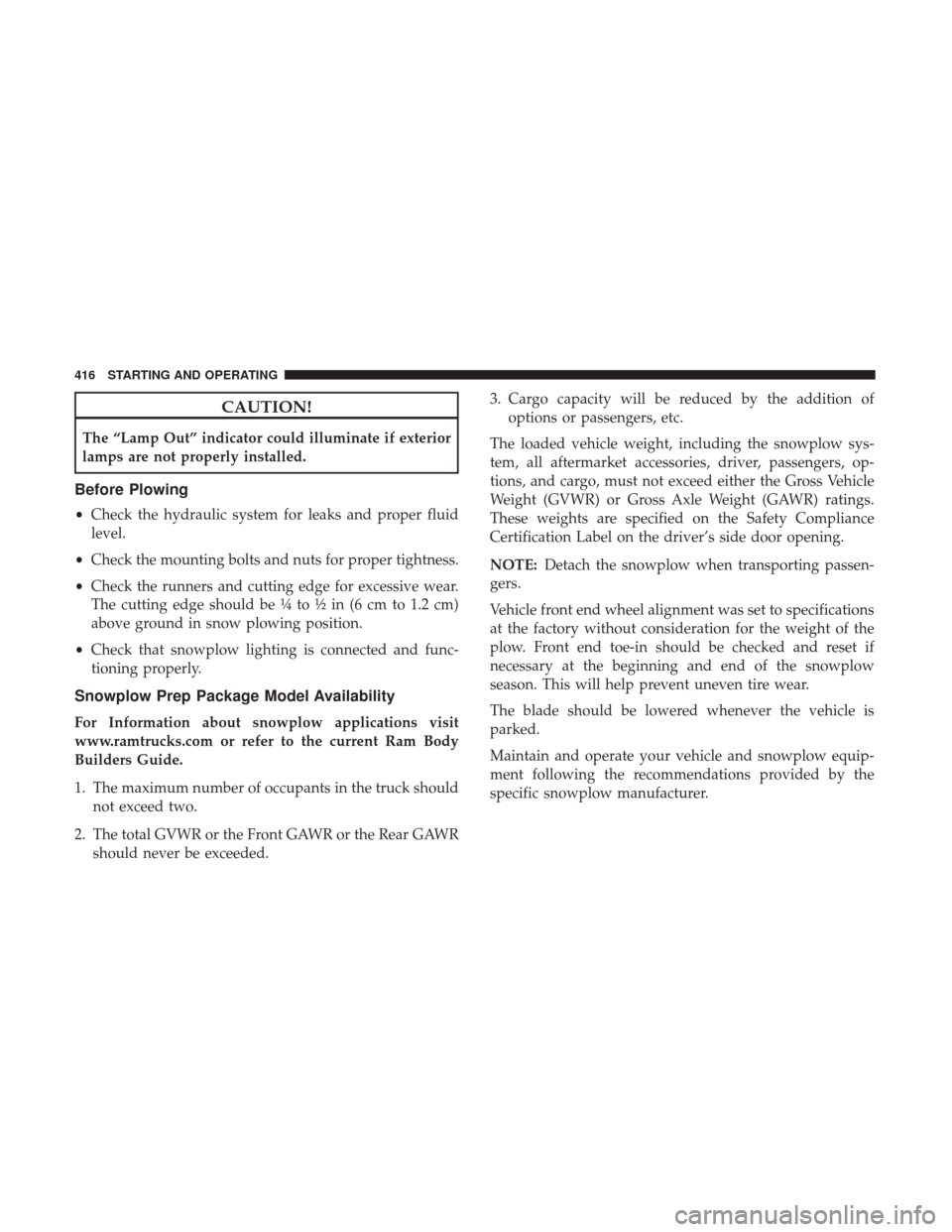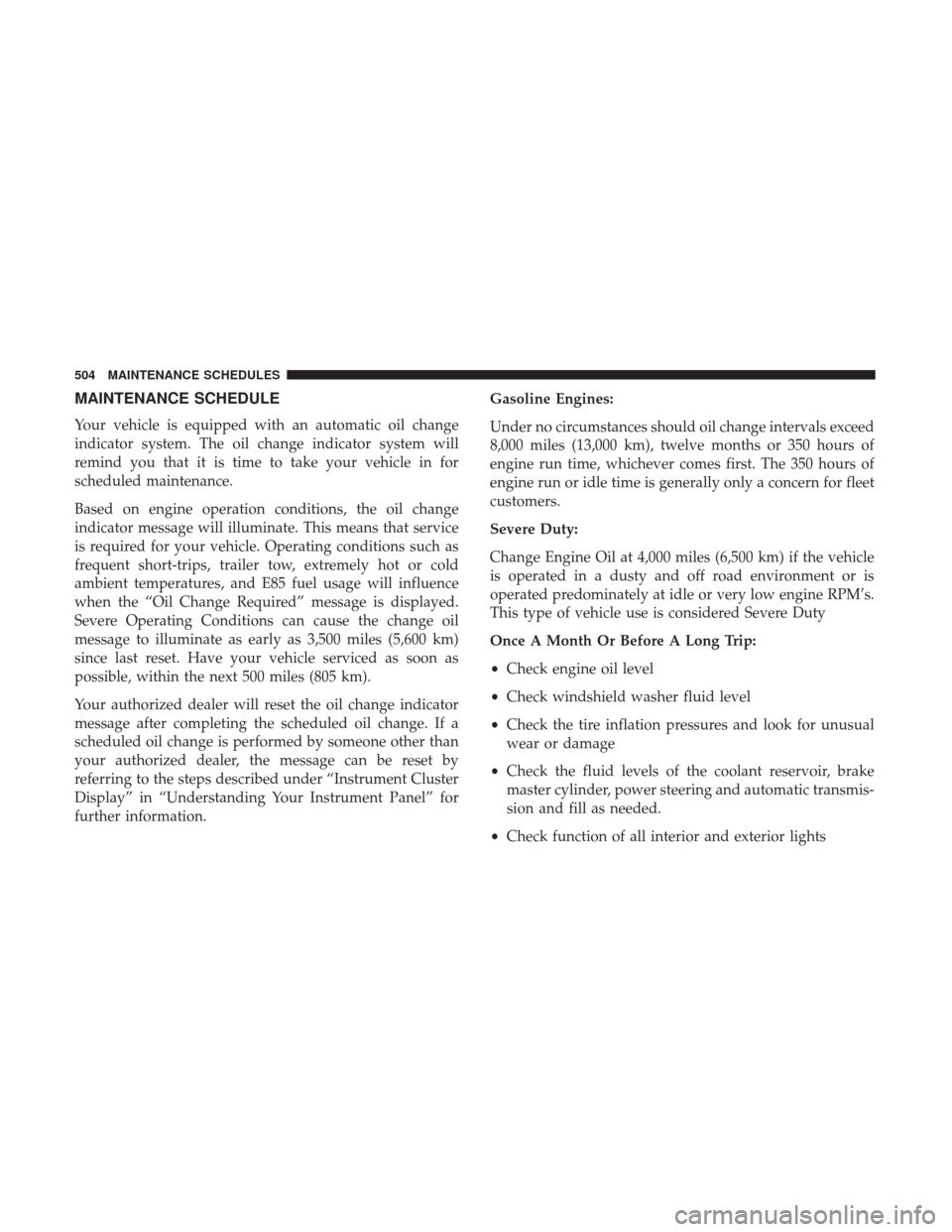reset Ram 5500 Chassis Cab 2017 Owner's Guide
[x] Cancel search | Manufacturer: RAM, Model Year: 2017, Model line: 5500 Chassis Cab, Model: Ram 5500 Chassis Cab 2017Pages: 534, PDF Size: 4.74 MB
Page 340 of 534

vehicle begins to move. To disengage PTO operation and
return to “standard vehicle operation” simply toggle the
on/off switch to the OFF position.
NOTE:For application specific information with respect
to PTO and pump requirements and additional vehicle
information (wiring schematics, preset idle values, engine
speed limits, and vehicle hardware and software require-
ments) please refer to the Body Builders Guide by access-
ing rambodybuilder.com and choosing the appropriate
links.
FOUR-WHEEL DRIVE OPERATION — IF EQUIPPED
Four-wheel drive trucks are equipped with either a manu-
ally shifted transfer case or an electronically shifted trans-
fer case. Refer to the operating instructions for your
transfer case, located in this section for further information.
Manually Shifted Transfer Case — If Equipped
The transfer case provides four mode positions:
• Two-Wheel Drive High Range (2H)
• Four-Wheel Drive Lock High Range (4H)
• Neutral (N)
• Four-Wheel Drive Low Range (4L) For additional information on the appropriate use of each
transfer case mode position, see the information below:
2H
Two-Wheel Drive High Range — This range is for normal
street and highway driving on dry, hard surfaced roads.
4H
Four-Wheel Drive Lock High Range — This range locks the
front and rear driveshafts together forcing the front and
rear wheels to rotate at the same speed. Additional traction
for loose, slippery road surfaces only.
NEUTRAL (N)
Neutral — This range disengages both the front and rear
driveshafts from the powertrain. To be used for flat towing
behind another vehicle. Refer to “Recreational Towing” in
“Starting And Operating” for further information.
4L
Four-Wheel Drive Low Range — This range locks the front
and rear driveshafts together forcing the front and rear
wheels to rotate at the same speed. Additional traction and
maximum pulling power for loose, slippery road surfaces
only. Do not exceed 25 mph (40 km/h).
338 STARTING AND OPERATING
Page 418 of 534

CAUTION!
The “Lamp Out” indicator could illuminate if exterior
lamps are not properly installed.
Before Plowing
•Check the hydraulic system for leaks and proper fluid
level.
• Check the mounting bolts and nuts for proper tightness.
• Check the runners and cutting edge for excessive wear.
The cutting edge should be ¼ to ½ in (6 cm to 1.2 cm)
above ground in snow plowing position.
• Check that snowplow lighting is connected and func-
tioning properly.
Snowplow Prep Package Model Availability
For Information about snowplow applications visit
www.ramtrucks.com or refer to the current Ram Body
Builders Guide.
1. The maximum number of occupants in the truck should not exceed two.
2. The total GVWR or the Front GAWR or the Rear GAWR should never be exceeded. 3. Cargo capacity will be reduced by the addition of
options or passengers, etc.
The loaded vehicle weight, including the snowplow sys-
tem, all aftermarket accessories, driver, passengers, op-
tions, and cargo, must not exceed either the Gross Vehicle
Weight (GVWR) or Gross Axle Weight (GAWR) ratings.
These weights are specified on the Safety Compliance
Certification Label on the driver’s side door opening.
NOTE: Detach the snowplow when transporting passen-
gers.
Vehicle front end wheel alignment was set to specifications
at the factory without consideration for the weight of the
plow. Front end toe-in should be checked and reset if
necessary at the beginning and end of the snowplow
season. This will help prevent uneven tire wear.
The blade should be lowered whenever the vehicle is
parked.
Maintain and operate your vehicle and snowplow equip-
ment following the recommendations provided by the
specific snowplow manufacturer.
416 STARTING AND OPERATING
Page 506 of 534

MAINTENANCE SCHEDULE
Your vehicle is equipped with an automatic oil change
indicator system. The oil change indicator system will
remind you that it is time to take your vehicle in for
scheduled maintenance.
Based on engine operation conditions, the oil change
indicator message will illuminate. This means that service
is required for your vehicle. Operating conditions such as
frequent short-trips, trailer tow, extremely hot or cold
ambient temperatures, and E85 fuel usage will influence
when the “Oil Change Required” message is displayed.
Severe Operating Conditions can cause the change oil
message to illuminate as early as 3,500 miles (5,600 km)
since last reset. Have your vehicle serviced as soon as
possible, within the next 500 miles (805 km).
Your authorized dealer will reset the oil change indicator
message after completing the scheduled oil change. If a
scheduled oil change is performed by someone other than
your authorized dealer, the message can be reset by
referring to the steps described under “Instrument Cluster
Display” in “Understanding Your Instrument Panel” for
further information.Gasoline Engines:
Under no circumstances should oil change intervals exceed
8,000 miles (13,000 km), twelve months or 350 hours of
engine run time, whichever comes first. The 350 hours of
engine run or idle time is generally only a concern for fleet
customers.
Severe Duty:
Change Engine Oil at 4,000 miles (6,500 km) if the vehicle
is operated in a dusty and off road environment or is
operated predominately at idle or very low engine RPM’s.
This type of vehicle use is considered Severe Duty
Once A Month Or Before A Long Trip:
•
Check engine oil level
• Check windshield washer fluid level
• Check the tire inflation pressures and look for unusual
wear or damage
• Check the fluid levels of the coolant reservoir, brake
master cylinder, power steering and automatic transmis-
sion and fill as needed.
• Check function of all interior and exterior lights
504 MAINTENANCE SCHEDULES
Page 531 of 534

Fluid................................ .502
Shifting .............................. .325
Transporting Pets ...........................93
Tread Wear Indicators ...................... .383
Turn Signals ....................... .137, 220, 494
Uconnect Customer Programmable Features .........249, 266
Operation ............................. .273
Uconnect Settings ....................... .239
Uconnect Settings .....................249, 266
Uconnect 8.4/8.4 NAV ...................... .314
Uconnect 8.4 Settings Customer Programmable Features — Units ......258
Uconnect Access Vehicle Health Alert ...................... .307
Uconnect Settings Customer Programmable Features .......34, 247, 264
Passive Entry Programming ...........34, 247, 264
Uconnect Settings .....................247, 264
Uconnect Voice Command ....................294
Uniform Tire Quality Grades ..................388
Universal Garage Door Opener (HomeLink) Programming HomeLink .........166, 167, 168, 169
Unleaded Gasoline ........................ .396Untwisting Procedure, Seat Belt
.................47
Vehicle Identification Number (VIN) ...............7
Vehicle Loading ....................... .373, 401
Vehicle Modifications/Alterations .................7
Vehicle Storage ........................ .292, 493
Viscosity, Engine Oil ....................... .453
Voice Recognition System (VR) .................294
Warnings And Cautions .......................6
Warranty Information ...................... .513
Washers, Windshield .....................139, 469
Washing Vehicle .......................... .481
Water Driving Through ........................ .348
Wheel And Wheel Trim ..................... .483
Wheel And Wheel Trim Care ..................483
Wheel Cover ............................. .434
Wheel
Nut Torque ..................... .433, 435
Wind Buffeting .............................40
Window Fogging .......................... .292
Windows .................................37
Power .................................37
Rear Sliding ........................... .187
Reset Auto-Up ...........................39
10
INDEX 529